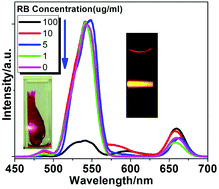Enhanced upconversion luminescence through core/shell structures and its application for detecting organic dyes in opaque fishes†
Abstract
Here, we report the enhanced upconversion luminescence of NaLuF4:18%Yb3+,2%Er3+ through core/shell structures. Among NaYF4, NaGdF4, and NaLuF4 shells, the first one presents the highest efficiency. These upconversion fluorescent nanoprobes with an oleic acid/PEG hybrid ligand can efficiently capture Rhodamine B (RB) and sodium fluorescein (SF) in opaque fishes to present their residues in vivo through luminescence resonant energy transfer (LRET) processes. It can be confirmed based on LRET technology that no RB is absorbed by opaque fishes after incubating in the aqueous solution of 1 μg ml−1 RB for one day, while SF residue can be obviously detected after incubating in the aqueous solution of 1 μg ml−1 SF for one day. The merit of this LRET technology with the upconversion nanoparticle (UCNP) donor is ascribed to the deep penetration depth of the infrared pumping laser and high signal to noise ratio.


 Please wait while we load your content...
Please wait while we load your content...